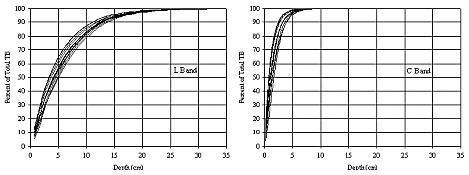
Research
The depth through which energy is emitted and sensed by microwave radiometers has been the subject of research and discussion for many years. The emitting layer has been variously referred to as the penetration depth, sampling depth, effective depth, contributing depth, and emitting depth although these are not necessarily equivalent terms. Despite what it is called, the emitting layer is more easily regarded as a concept rather than a specific quantity because the thickness of the layer is defined somewhat arbitrarily, differs with regards to the wavelength of the emitted energy, and changes as a function of moisture and temperature conditions. Theoretical and empirical evidence suggest that the optimal frequency for remote sensing of soil moisture is L band (~1.4 GHz) (cf. Jackson, 1993) because at longer wavelengths the emitting layer is thicker due to less scattering and attenuation. Jackson and Schmugge (1989) and more recently Jackson et al. (1997) summarized early modeling and experimental results pertaining to emitting depth. A vast amount of literature has been generated on the subject and there is overwhelming agreement that most of the emitted energy is derived from a soil layer no thicker than about 10% to 25% of the wavelength.
 |
| Figure 1: Plots showing the cumulative contribution to emitted brightness temperature as a function of depth for a range of soil moisture conditions. Results are given for L and C band. |
Soil moisture values that are retrieved by inversion of passive microwave brightness temperatures are effective values dependent on the vertical distribution of moisture (and temperature) in the soil. Thus, there exists a discrepancy between the observed mean moisture and retrieved soil moisture. The error associated with correlating average moisture for a fixed layer with moisture retrieved from effective emissivity is lumped into overall error associated with numerous assumptions and generalizations used in the retrieval algorithm. The emitting depth function can be used to isolate the bias between observed near-surface mean soil moisture and retrieved effective moisture. If the observed near-surface moisture profile can be weighted by the emitting depth function, at least a portion of this bias could be removed. See “Converting Remotely Sensed Soil Moisture to Effective Moisture.”
Acknowledgements:
This research was supported by NASA through grant no. 291-07-75-90 to Universities Space Research Association and grant no. NCCW-0084 to Alabama A&M University , Center for Hydrology, Soil Climatology and Remote Sensing. This work was conducted in collaboration with Dr. Frank Archer of Alabama A&M University .
References Cited:
Jackson,T.J. 1993. Measuring surface soil moisture using passive microwave remote sensing. Hydrol. Proc., 7:139-152.
Jackson, T.J., and Schmugge, T.J. 1989. Passive microwave remote sensing system for soil moisture: some supporting research. IEEE Trans. Geosci. Rem. Sens. 27:225-235.
Jackson, T.J., O’Neill, P.E., and Swift, C.T. 1997. Passive microwave observation of diurnal surface soil moisture. IEEE Trans. Geosci. Remote Sensing, 35:1210-1222.
Laymon, C.A., Crosson, W.L., Jackson, T.J., Manu, A., and Tsegaye, T.D. 2001. Ground-based passive microwave remote sensing observations of soil moisture at S-band and L-band with insight into measurement accuracy. IEEE Trans. Geosci. Remote Sensing, 39:1844-1858.







